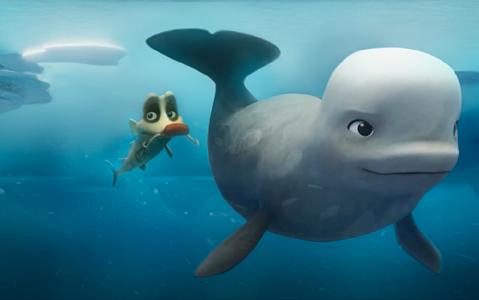
5 minute read
KAllE KOSMO nAUT
from ECFA Journal September 2022
by ECFA
Tine kugler & Günther kurth about kALLE kOSMONAUT
Advertisement
She was a lecturer in media sociology at the University of Konstanz who discovered her passion for film when working on a documentary film; he was a self-employed director, editor and producer. Together Tine Kugler and Günther Kurth (KMOTO production company) have made the touching feature documentary KALLE KOSMONAUT about Pascal, known as ‘Kalle’. With great sympathy and unlimited respect, they lead us into Kalle’s world, primarily characterised by shortcomings.
KALLE KOSMONAUT premiered at the Berlinale 2022. The directing couple Kugler/Kurth first met their protagonist in Berlin, more than 10 years ago…
Tine Kugler: In 2011 I was at The Arche children & youth centre in Berlin-Hellersdorf, when suddenly the door opened, Kalle walked in and started talking. I thought he was just great; curious, self-reflective and open. I called his mother about 50 times to get her consent and finally we started filming. The result was broadcast in 2011 under the title PASCAL ALONE AT HOME - Kalle suggested that title in reference to the film HOME ALONE. Günther Kurth: The film got great responses and donations kept on coming in the shape of money and gifts, including a skateboard and - unfortunately - a Playstation. Apparently we weren’t the only ones touched by Kalle’s story…
Afterwards you kept in touch?
Kurth: We are from Munich, but we met whenever we were in Berlin, and Pascal often spent the holidays at our place. At some point we started following him again with a camera. We applied for a feature documentary TV grant (Kleines Fernsehenspiel) and then later the BKM (Federal Government’s Film Funding Agency) came on board.
So you were back at his house, with his buddies with whom he performed his stunts on the city’s heating pipes; with his mother who was still working in the hardware store; with his grandparents who wished for the GDR to return and his grandma who gained control over her alcohol problem over time. You followed kalle throughout his years of initiation: his mother’s wedding, his first girlfriend and yes… also at the police station.
Kugler: I was touched by this policewoman, coming from the same neighbourhood, who stood up for him and got upset when Kalle started to stray from the right path again. Sometimes he told us he couldn’t be filmed; he was simply feeling too bad. Then we just stayed around for days in Berlin, sitting and talking together. Kurth: Right from the start we were aware of our responsibility towards him; that also applied dealing with his criminal offence. We had to carefully think about a) what exactly we wanted to tell about it and b) how to incorporate it into our story. All this
was thoroughly discussed with Kalle.
Did you foresee kalle’s criminal future?
Kurth: Never! We knew there had been some minor skirmishes and petty crimes, but not such a punishment! Two years! In those days we had little contact and Kalle didn’t reach out to us either. He was on drugs and for no reason hit a man, for which he felt bitterly sorry. Yes, I blamed myself for that! I’m not a social worker nor am I his father, but it appeared to me that a father figure was missing - he simply didn’t have a male reference person in his life. Kugler: The detention system is totally frightening, locked away in a place where nobody can help or protect you. A judicial officer told us that you can’t protect yourself in this system, you simply have to endure it and deal with it. Kurth: Each of us - his brother, his mother, the police officer, the social worker and we too - asked ourselves what we could have done. But Kalle said: you couldn’t have done anything at all, I have to pay for it myself...
Then you came up with the idea of comic book drawings.
Kurth: We weren’t allowed to film Kalle in prison, and we couldn’t get inside his head without visualising it. That’s when we remembered Alireza Darvish’s minimalistic drawings in CAMP 14, a documentary about North Korea’s infamous prison camp. Throughout the project we developed a time-consuming but very nice collaboration with this German-Iranian artist.

What did Kalle think about it?
Kurth: He basically saw himself as a cartoon character, and a stranger to himself. After the first screening, Kalle said: In fact, we all should have a camera following us for 10 years, to get to know ourselves better.
How much material did you collect in the end?
Kurth: We calculated 34 days of shooting, and did maybe 10 more. All the scenes are ‘one-takers’, you can feel that nothing was staged or rehearsed or re-shot. Kalle had his own idea of how he wanted to see himself represented. It was important for him to also show his negative sides, even if it scared him somehow.
Despite everything, kalle seems to be grounded.
Kugler: Which gives me hope for his future. Because the difficulties after two years in prison cannot be underestimated. There is hardly any help there – he was of course supervised in keeping him away from drugs, but furthermore there was nobody. He doesn’t have an apartment, and he can’t find one because he doesn’t have a job. From time to time he works in demolition, but still lacks the stamina for an apprenticeship. He takes care of his former girlfriend’s child; although they are no longer together, they support each other. Kurth: It would be nice if this film could stimulate offering chances to people, no matter where they come from, even if there is no way to sugarcoat their criminal background
What about the title?
Kugler: The word ‘Kosmonaut’ explains a lot… the hope that if you want to fly to the stars, you can do it.
–
Uta Beth










